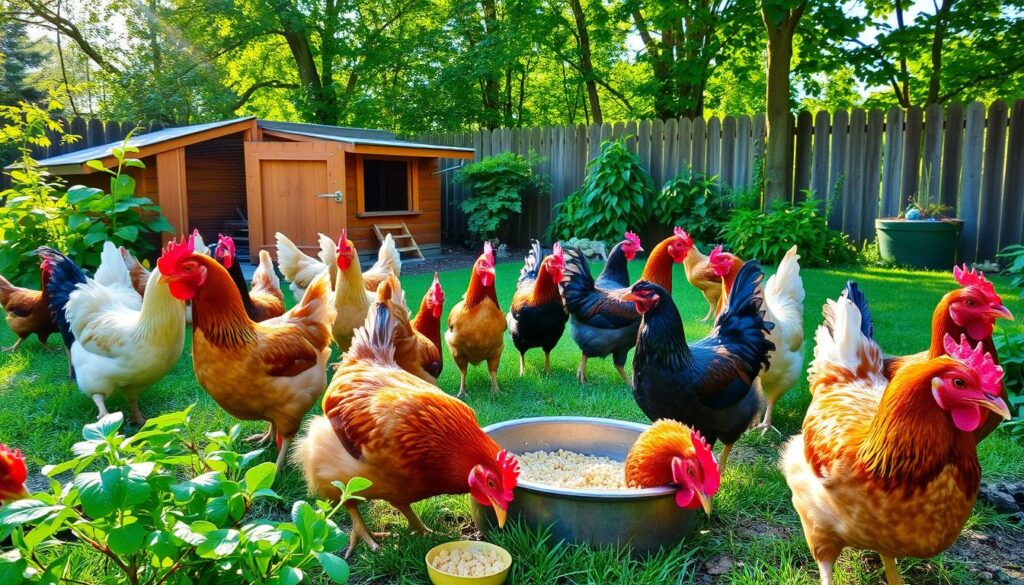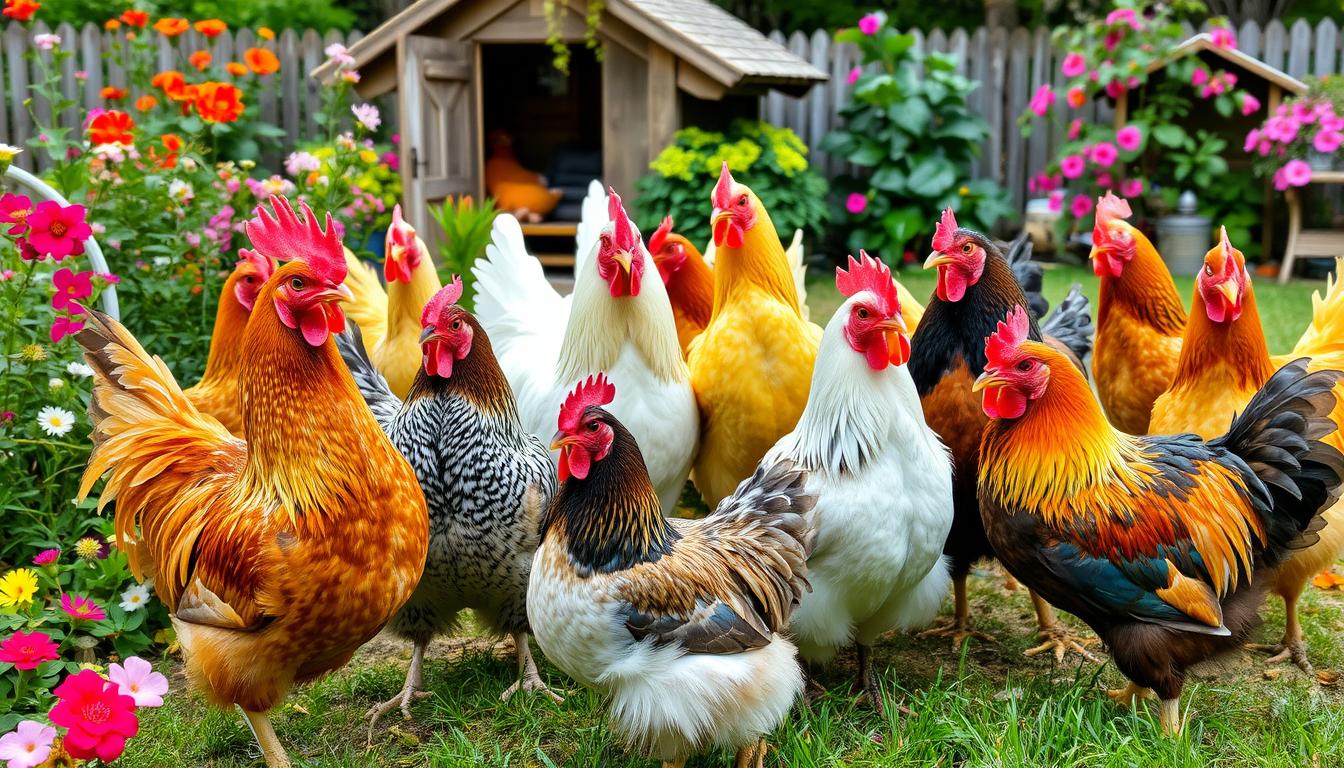Discover the vibrant world of color pack chickens, a colorful addition to any backyard. These birds have won the hearts of chicken lovers in the UK. They bring stunning visuals and benefits for homesteaders. This guide will show you the best breeds, their origins, and what to consider before starting your colorful chicken journey.
Key Takeaways
- Color pack chickens are a diverse group of breeds that showcase a stunning array of plumage colors and patterns.
- These birds offer a visually appealing addition to backyard flocks, with the potential to produce vibrant, distinctive eggs.
- Selecting the right color pack breeds for your needs and setup is crucial for a successful and enjoyable chicken-keeping experience.
- Proper care, nutrition, and management are essential to maintain the health and vibrant appearance of your color pack flock.
- Opportunities abound for marketing and selling the unique eggs produced by your color pack chickens.
Understanding Color Pack Chickens and Their Appeal
Color pack chickens are a stunning group of birds that have won the hearts of many. They are not just beautiful to look at. They also bring many benefits to a backyard flock.
Definition and Origin of Color Pack Breeds
Color pack chickens have vibrant feathers in many colors. They were bred to show off their beauty. These birds come from different heritage breeds and are loved in poultry processing and chicken coloring.
Benefits of Keeping Multi-Colored Flocks
Color pack chickens are more than just pretty. They make your backyard look better and help your flock be healthier. They can even make more eggs and better meat. Keeping them is a great way to enjoy avian diversity.
| Benefit | Description |
|---|---|
| Aesthetic Appeal | The vibrant and varied plumage of color pack chickens adds a visually stunning element to any backyard coop, creating a true feast for the eyes. |
| Improved Egg Production | Studies have shown that a genetically diverse flock can lead to higher egg production, ensuring a bountiful supply of fresh, colorful eggs. |
| Enhanced Meat Quality | The diverse genetic makeup of color pack chickens can contribute to improved meat texture, flavor, and nutritional value, making them a premier choice for the discerning poultry enthusiast. |
Keeping color pack chickens is a rewarding experience. It makes your backyard flock better and adds color to your life.
Essential Factors to Consider Before Starting Your Flock
Starting a color pack chicken flock requires careful planning. It’s important to prepare well to enjoy a successful chicken-keeping experience.
First, think about the space requirements for your coop. Color pack chickens need more room than regular breeds. Make sure your outdoor space can fit your flock without being too crowded.
Next, learn about the local regulations for keeping chickens. Many places have rules and restrictions. It’s crucial to follow these to avoid legal trouble.
The initial costs for starting a flock can be high. Consider the cost of chicks or hens, building or fixing a coop, and buying flock management tools.
Lastly, think about the time commitment for your chickens. Color pack breeds need extra care, like grooming and special diets. Make sure you can give them the time and effort they need.
| Consideration | Importance |
|---|---|
| Space Requirements | Crucial for the well-being and comfort of your color pack chickens |
| Local Regulations | Necessary to comply with municipal guidelines and avoid legal issues |
| Initial Costs | Significant investment for purchasing chicks/hens and setting up the coop |
| Time Commitment | Substantial dedication required for grooming, nutrition, and overall flock management |
By thinking about these key factors, you can start a successful and enjoyable journey with your color pack chicken flock.
Top Color Pack Chicken Breeds for Beginners
If you’re new to chicken keeping, there are many colorful breeds perfect for you. These chickens add beauty to your backyard and are great for small farms. They’re easy to care for and fun to watch.
Easter Eggers and Ameraucanas
Easter Eggers and Ameraucanas lay blue, green, or pink eggs. They’re friendly, hardy, and easy to care for. Their calm nature and reliable egg-laying make them a favorite in the UK.
Wyandottes and Orpingtons
Wyandottes and Orpingtons are great for beginners. Wyandottes have colors like silver, gold, and blue. Orpingtons have buff, white, and black. Both are friendly, healthy, and lay eggs regularly.
Plymouth Rocks and Sussex
Plymouth Rocks and Sussex give a classic farm look. Plymouth Rocks have a barred pattern. Sussex chickens come in speckled, brown, and white. They’re adaptable, lay eggs well, and fit in free-range or coop settings.
These breeds are perfect for new chicken keepers in the UK. They have beautiful colors, lay eggs well, and are easy to care for. They add beauty to your backyard flock.
Setting Up Your Backyard Coop for Color Pack Breeds
Creating the perfect home for your color pack chickens is key to their health and happiness. The size of the coop and features that highlight their beauty are crucial. Every detail in backyard coop design matters for a cozy and functional chicken housing.
Coop Essentials for Color Pack Chickens
The size of the coop is very important. It should have at least 4 square feet per bird. This ensures they have enough space to move and behave naturally. Good ventilation is also essential to keep the air clean and the temperature right.
- Provide a spacious and well-ventilated coop
- Incorporate nesting boxes for egg-laying
- Ensure ample roosting areas for nighttime perching
- Include features that showcase the birds’ vibrant plumage
Nesting boxes and roosting areas are vital for your chickens’ comfort and security. Adding elements that highlight their feathers, like perches or shelves, can be beautiful. These features catch the light and show off the birds’ natural beauty.
By designing your backyard coop with care, you can make a welcoming space for your color pack flock. This ensures their health, happiness, and chance to thrive.
Nutrition Requirements for Vibrant Feathers
Keeping a flock of color pack chickens healthy means focusing on their diet. Their bright feathers show they are well-fed and happy. Let’s look at the vitamins, minerals, and food choices that make their feathers pop.
Essential Vitamins and Minerals
The diet greatly affects a chicken’s feather health and color. Key nutrients for bright feathers include:
- Vitamin A – Helps feathers grow and stay healthy.
- Vitamin B12 – Important for feather color and pigmentation.
- Vitamin E – Protects feathers from damage and makes them shiny.
- Zinc – Crucial for feather growth and strength.
- Copper – Helps create melanin, the pigment that colors feathers.
Best Feed Options
Choose the right food to meet your chickens’ nutritional needs. Here are some good options:
- A top-notch layer feed with the right mix of vitamins, minerals, and protein.
- Supplement with marigold or paprika to boost feather color.
- Include whole grains like millet, wheat, and corn for extra nutrients and fiber.
- Add fresh fruits and veggies, especially dark leafy greens, for vitamins and minerals.
By focusing on your chickens’ diet, you can keep their feathers bright and their health top-notch. With the right nutrients, your flock will look amazing.
| Nutrient | Benefits for Feather Health |
|---|---|
| Vitamin A | Supports the growth and maintenance of healthy feathers |
| Vitamin B12 | Plays a crucial role in feather pigmentation and coloration |
| Vitamin E | Helps protect feathers from oxidative damage and enhances their sheen |
| Zinc | Necessary for proper feather development and structure |
| Copper | Contributes to the formation of melanin, the pigment responsible for feather color |
Health Management and Disease Prevention
Keeping your color pack chicken flock healthy is key for their productivity and your safety. It’s important to manage their health and prevent diseases. This way, your chickens stay healthy, and your food is safe to eat.
Vaccination and Parasite Control
Vaccinating your chickens against diseases like Marek’s disease and Newcastle disease lowers disease risk. Regular deworming and parasite control also prevent health issues. These steps are crucial for chicken health and food safety.
Regular Health Checks
- Do weekly checks on your flock for illness signs.
- Watch for parasites like mites and lice and deal with them fast.
- Make a health plan with your vet, including regular check-ups and tests.
Biosecurity Measures
Strict disease prevention steps are vital. Clean the coop, limit visitors, and stay clean. A clean, well-ventilated home is essential for chicken health and food safety.
| Common Chicken Health Issues | Preventive Measures |
|---|---|
| Respiratory Infections | Vaccination, Proper Ventilation, Biosecurity |
| Parasitic Infestations | Deworming, Coop Cleaning, Parasite Control Products |
| Egg-Laying Problems | Balanced Nutrition, Stress Reduction, Veterinary Guidance |
A good health management and disease prevention plan keeps your flock healthy. This ensures your eggs and meat are of high quality and safe to eat.

Breeding and Genetics of Colorful Chickens
Understanding the genetics behind colorful chickens is key for successful breeding. It helps keep the flock’s traits consistent. Let’s explore chicken genetics, color inheritance, and breeding techniques.
Color Inheritance Patterns
Chicken colors come from genes and their variations. The main genes are E, C, I, and D. These genes mix in different ways, creating many colors in colorful chicken breeds.
The E locus controls red, brown, and black colors. The C locus decides if a bird is solid or patterned. The I locus can block certain colors, and the D locus makes colors lighter.
Selective Breeding Tips
To keep your flock colorful, focus on selective breeding. Choose breeders with the right colors and genetics. This ensures their offspring will have the traits you want.
- Decide on the color pattern and traits you want, like specific colors or feather patterns.
- Look at your flock and pick birds that match your breeding goals.
- Keep detailed records of your breeding program, including lineage and color inheritance.
- Be patient and consistent, as it may take several generations to achieve the desired traits.
- Seek advice from experienced breeders or scientific resources to understand color genetics.
By knowing color inheritance and using selective breeding, you can create a stunning flock. Your backyard neighbors will be jealous of your colorful chickens.
| Genetic Locus | Trait | Examples of Observed Effects |
|---|---|---|
| E (Extension) | Controls the expression of red, brown, and black pigments | Influences the overall color pattern, such as solid colors, barring, and mottling |
| C (Color) | Determines whether the bird will be self-colored or have a pattern | Affects the distribution and intensity of color across the feathers |
| I (Inhibitor) | Can inhibit or restrict the expression of certain colors | Reduces or suppresses the expression of specific pigments |
| D (Dilution) | Can dilute the intensity of the pigments | Results in lighter shades of colors, such as lavender or pale blue |
Egg Production and Quality Control
As a backyard chicken lover, you’ve probably noticed the bright colors and special traits of your flock. But did you know they can also lay great eggs? Many color pack chicken breeds are known for their consistent and high-quality egg production.
Keeping a color pack flock means you’ll get a variety of egg colors. You might see everything from rich brown to stunning blue-green. But, it’s important to keep the quality and consistency of your eggs up, especially if you sell them.
Factors Affecting Egg Color and Quality
The color and quality of your eggs depend on several things:
- Breed genetics
- Nutrition and diet
- Hen health and age
- Environmental conditions in the coop
By managing these factors well, you can make sure your eggs are top-notch for egg production and quality control.
Adhering to Food Regulations
If you want to sell your eggs, you need to know the food regulations in your area. This includes getting the right licenses, following labeling rules, and keeping up with food safety. By doing this, you can sell high-quality eggs and follow the law.
“Producing high-quality, visually appealing eggs is a point of pride for many color pack chicken owners. With the right care and attention, your backyard flock can become a source of delicious and nutritious eggs for your family and community.”
Take pride in the eggs your color pack chickens give you. Focus on egg production, quality control, and food regulations to make the most of your flock.

Seasonal Care for Your Color Pack Flock
Keeping your color pack chicken flock healthy and colorful all year needs some planning. You must adjust how you manage them with the seasons. This includes handling the heat in summer and keeping them warm in winter. Knowing what your chickens need each season is crucial for their health and production efficiency.
Summer Heat Management
When it gets hot, color pack chickens can struggle. To keep them cool and manage your flock well, try these tips:
- Make sure they have plenty of shade and air in their coop to control the temperature.
- Keep water clean and cool for them to drink and stay hydrated.
- Feed them when it’s cooler and give them smaller meals more often.
- Use coolers like misting systems or frozen water bottles in the coop to cool things down.
Winter Protection Strategies
When winter comes, your care for your chickens must change. Here’s how to keep your color pack chickens warm:
- Insulate the coop to keep it warm and prevent cold air from getting in, but also make sure it’s well-ventilated.
- Use a thick layer of bedding like pine shavings to keep them warm and off the cold ground.
- Think about adding a heat source like a heat lamp or radiant heater to keep the coop cozy.
- Give them more protein and fat in their food to help them stay warm and have enough energy.
By taking care of your color pack flock’s seasonal needs, you can keep them healthy and productive all year. Their bright colors will stay vibrant too.
Marketing and Selling Color Pack Eggs
As a small-scale egg producer in the United Kingdom, you can tap into the growing demand for unique eggs. Your colorful chickens give you a unique edge in the market. By using smart marketing and following local rules, you can connect with your customers effectively.
It’s important to label your eggs properly. Show the breed, farm name, and any certifications on your packaging. This makes your eggs look good and builds trust with buyers. Also, make sure your labels meet UK standards for small egg producers.
Keeping a loyal customer base is key to selling eggs well. Get involved in local markets, have an egg stand, or partner with stores. Use social media to show off your eggs’ colors and quality. This way, you can build a loyal group of customers who are willing to pay more for your eggs.

